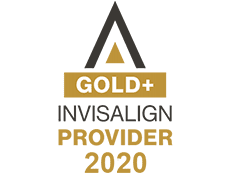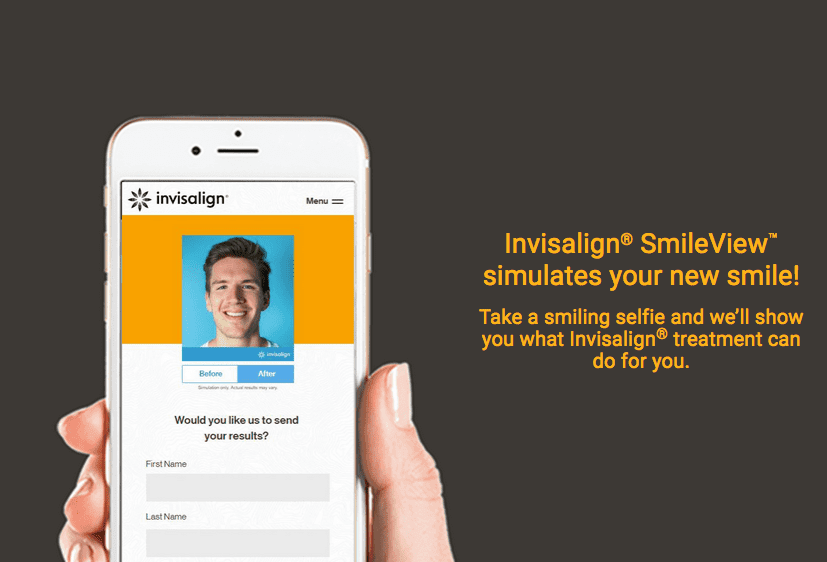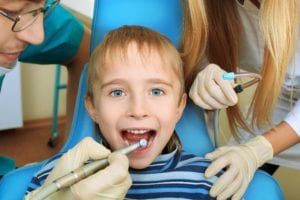 Invisalign® is an orthodontic appliance system used to inconspicuously treat crooked and crowded teeth in adults and teens. This modern take on braces features a system of clear aligner trays that are worn at all times with the exception of during meals and when brushing or flossing. The trays are custom fitted to the teeth, making them virtually unnoticeable when laughing, talking, and eating with other people. Patients receive a sequence of trays, each of which is slightly different than the one before. The aligners provide a slight resistance to the teeth, forcing them to move into alignment over time. With Invisalign®, adults and teens can achieve the smiles they’ve always wanted without feeling self-conscious about the mode of treatment.
Invisalign® is an orthodontic appliance system used to inconspicuously treat crooked and crowded teeth in adults and teens. This modern take on braces features a system of clear aligner trays that are worn at all times with the exception of during meals and when brushing or flossing. The trays are custom fitted to the teeth, making them virtually unnoticeable when laughing, talking, and eating with other people. Patients receive a sequence of trays, each of which is slightly different than the one before. The aligners provide a slight resistance to the teeth, forcing them to move into alignment over time. With Invisalign®, adults and teens can achieve the smiles they’ve always wanted without feeling self-conscious about the mode of treatment.
Did you know…
wearing Invisalign® is in no way as restrictive as traditional braces? Many adults opt for this system not only because it is discreet, but also because there is no need to change your diet to avoid foods that could damage braces. This is because the Invisalign® system is free of braces and brackets, instead opting for a removable tray that can be taken out prior to meals. Also, Invisalign® fits well into busy adult schedules, as there is no need to attend frequent visits for wire tightening. Most patients simply change to a new aligner tray every couple of weeks.
We now offer Invisalign® SmileView. You will be able to see a simulation of the results for your treatment.

If you have crooked or crowded teeth that are embarrassing to you or otherwise preventing you from achieving optimal oral health, Invisalign® could be the solution for you. Visit your Invisalign® dentist for a complete consultation to find out if you could benefit from clear orthodontics.
You will wear your aligners nearly all of the time, with the exception of about two hours per day. Invisalign® treatments are different for everyone, but most patients can achieve their ideal smiles within one to two years. During that time, you can expect to make occasional dental visits to monitor your progress.
Following your treatment, you will no longer need to wear Invisalign® trays. However, you will need to wear a retainer each day to help protect your new smile. It is also important to continue visiting your dentist for routine check-ups and twice-yearly cleaning.
At Battery Park Pediatrics, we aim to help your child achieve optimal oral health by focusing on preventative dental care. A key element to preserving oral health is to simply prevent dental issues from ever occurring. The prevention of dental issues will ensure that less invasive treatments are needed, which will help your child form a positive relationship with our dentists that will shape positive oral habits for the rest of their life. Battery Park Pediatrics provides the following preventative dental services:
During an oral exam, our dentists will evaluate your child’s teeth, bite, gums, and the surrounding structures for any signs of dental issues. Regular oral exams, performed at least every six months, ensure that dental issues can be resolved before they have a chance to escalate.
During a teeth cleaning, our dental hygienists will use a special tool, called a scaler, to very gently scrape the excess plaque and tartar off your child’s teeth. Then, they will go over the teeth with a gritty toothbrush and an electric brush to get any missed areas. Next, they will floss between your child’s teeth to ensure they have removed all the plaque and tartar from hard to reach areas. Your child will then rinse their mouth and have a fluoride polish applied to their teeth. Regular teeth cleanings, performed in coordination with dental checkups, prevent harmful decay-causing bacteria from building up within plaque and tartar deposits.
To prevent your child from developing cavities in the grooves of their molars, a thin, plastic coating is painted over these grooves, effectively sealing them from plaque and food. Dental sealants are especially useful to prevent tooth decay in young children who may have trouble brushing properly.

These are conducted during oral exams and can help your child prepare for orthodontic treatment if needed. Pre-orthodontic exams aim to identify and correct possible issues in preparation for later orthodontic treatment.
To monitor the growth and development of your child’s teeth and facial bones, our dentists will perform regular dental x-rays. These x-rays are perfectly safe and have very low radiation levels.
Every time your child visits our office, our staff will teach them about the importance of oral hygiene and will show them proper brushing and flossing techniques. This is important so they can develop positive oral habits.
Did You Know?
Other than the common cold, tooth decay is one of the most common diseases. In fact, approximately 75% of worldwide school children have dental cavities caused by tooth decay.

Having your child visit Battery Park Pediatrics for their dental checkup and teeth cleaning at least once every six months ensures that their teeth will be clean, healthy, and are more likely to remain that way. Preventative dentistry services allow our dentists to eliminate possible dental issues before they have a chance to get worse.
If your child is showing signs of tooth decay or damage, then restorative dental services may be needed. The most commonly used restorative treatments for children are fillings, crowns, and nerve treatment. The intention of restorative treatments is to effectively restore function to the tooth and prevent the condition from causing tooth loss or the need for extraction.
Since the majority of general dentistry services are preventative, your child should expect to undergo an oral exam, dental x-rays, and a teeth cleaning at their appointment. During the oral exam, our dentists will use special tools to look inside your child’s mouth. Although these tools may look scary to your child, you can explain to them that they will cause no pain and are only used so the dentists can properly see everything. Dental x-rays are relatively quick and may consist of your child biting down on a plastic disc. Finally, their teeth will be cleaned and polished. At the end of their appointment, you will be able to discuss their results with our dentists and get any questions answered.
If your child needs to have restorative work done, our dentists will explain what the process is and what to expect. The expectations for restorative work depend upon the type of work being done. Generally, to make the experience easier on your child, we will schedule their restoration work for a different day and offer conscious sedation.
After you child’s dental check up and teeth cleaning, you will need to schedule their next check up and teeth cleaning. In the meantime, make sure your child continues to brush twice daily and floss once daily. Make sure they are using fluoridated toothpaste that has been approved by the American Dental Association (ADA) and don’t forget to replace their toothbrushes when the bristles begin to fray, which usually amounts to three to four times a year.
To prevent cavities, limit the amount of sugar they consume and make sure they brush their teeth after eating or drinking anything containing large amounts of sugar. You will also want to make sure they eat a balanced diet so that their teeth are receiving adequate amounts of nutrients. Foods like cheeses, apples, and broccoli are especially beneficial to your child’s oral health.
You should also monitor their oral health and call our office immediately if anything changes or if they complain about any pain or discomfort. Also, if your child plays sports, they should be fitted for a mouthguard to prevent oral injuries from occurring.
Childhood dental habits establish the foundation for oral health during adulthood. By training children about proper hygienic habits at an early age, parents and caregivers can set them up for a lifetime of good oral health.
A child’s first visit to the dentist should fall around his or her first birthday. This is the time when many of the baby teeth have erupted into the gums, and it is approximately six months following the breakthrough of the first baby tooth. It is important to make visits to the dentist an exciting experience for young children. Parents should speak with children openly about an upcoming dental appointment and answer any questions a child may have about the experience. Equally important is the dentist chosen to care for a child’s teeth. Although all dentists are qualified to care for a child’s oral health, many parents prefer the expertise and experience available from a pediatric dentist or a family dentist with experience caring for young patients. Furthermore, dentists with experience working with children are accustomed to squirming and are more likely to have child-friendly waiting areas.
By the age of three, most children have 20 teeth often referred to as baby teeth. Children are born with these teeth, although they do not appear until several months of age. Although these teeth will eventually fall out usually beginning around the child’s sixth birthday they are still susceptible to decay until that time. During childhood, the dentist will inspect the baby teeth for cavities and signs of decay, as well as ensure the teeth are erupting normally. As the child grows, dental visits continue according to a schedule determined by the dental care provider.
Parents are also instructed on proper home dental care and advised of day-to-day habits that could cause early decay. Caution may be given about:
At-home dental care is equally important as visiting the dentist on a regular basis. Even before the teeth erupt in a child’s mouth, the gums should be gently washed each day. Twice-daily brushing should begin as soon as the teeth break through the gums, although the teeth may initially be cleansed using water, rather than toothpaste. As the child gets older, it is safe to begin using children’s toothpaste as recommended by the child’s dental provider.
Sedation dentistry has become increasingly possible in modern dental work and has helped to change the way patients are affected by dental work. Sedation dentistry helps to relax anxious children so that their dental treatment can be completed quickly, safely, and without the trauma of pain or fear. At Battery Park Pediatrics, we offer conscious sedation as a method of providing your children with the best possible dental experience. Conscious sedation is a moderate form of sedation that allows your child to be awake, but relaxed and pain-free. Many times, children who have undergone conscious sedation do not remember the procedure.
Did You Know?
Dental sedation has been around since the 19th century and not only helps alleviate dental anxiety, but can also be helpful for those with a strong gag reflex or who don’t like sitting still.
Battery Park Pediatrics provides the following sedation options:
Before your child’s procedure, our dentists will discuss the necessary preparations with you. Depending on the type of sedation, our dentists may tell you to not let your child eat or drink non-clear liquids after midnight. Then you will want to stop all clear liquids two hours before their procedure. To help make the experience easier for your child, you will want to make sure they are in comfortable clothes, have closed toed shoes, and have them bring a favorite toy or blanket for support. You will also want to remain calm and reassuring.
Once the procedure is over, you can accompany your child as they come out of sedation. Some children bounce back from sedation quickly, while others take a little longer. As the medication wears off, your child may have different reactions. Crying, being fussy, feeling nauseous or dizzy, or even vomiting are normal reactions and should cease when the medication wears off. They may also experience drowsiness for the rest of the day and should be kept home from school or other activities to relax.
For the first two hours after the procedure, your child may still experience numbness in their nose, mouth, throat, and tongue. Because of this, you will need to watch them carefully when eating or drinking to make sure they do not accidentally choke or bite the insides of their mouth. You should also only feed them soft foods in the hours following their dental procedure.
If your child has a fever, severe bleeding of the gums, severe pain, or is vomiting for more than 24 hours, call our office immediately. After treatment, our office will provide you will special guidelines that explain what other things to look out for and how to remedy these situations.
Recently, people have begun to question whether or not sedation dentistry is safe for children. While there are always risks associated with any medical procedure, sedation dentistry is considered to be safe for children if performed correctly. This means that the dentists administering the sedation are properly trained and that the office follows all the sedation safety protocols. During your child’s procedure, their blood pressure, heart rate, and oxygen levels will all be carefully monitored for changes.
Furthermore, as a parent there are things you can do to minimize any possible risks associated with dental sedation. First, you will want to make sure you inform our dentists about your child’s medical history and about any medications they are taking. If your child has sleep apnea, loud snoring, large tonsils or adenoids, or is obese, you will also want to discuss these things with our dentists. Next, you will want to follow all of our pre-treatment guidelines and make sure your child follows them as well. Finally, trust your instincts as a parent and call immediately if you suspect your child isn’t acting like themselves.
Sedation is most commonly used for young children who are unable to cope with the delivery of dental care, children who have a high level of anxiety and for some children with special needs. Procedures such as fillings, crowns, root canals, and extractions often require sedation.Sedation is recognized by the American Academy of Pediatric Dentistry as an effective way to make many children comfortable during their dental visit. Before administering any sedative or anesthetic to your child, your NYC sedation dentist will talk to you about the process of sedation and pre- and post-sedation instructions.
The American Academy of Pediatric Dentistry endorses the use of nitrous oxide/oxygen inhalation therapy as a safe and effective technique to reduce anxiety and decrease pain. The gas (a mixture of nitrous oxide and oxygen) is administered by inhaling through a flavored nasal mask in which your child will smell a sweet, pleasant aroma. Patients are still conscious and can talk to their dentist during their visit. Nitrous oxide is one of the safest sedative treatments in dentistry. It has a rapid onset, and the effects wear off almost immediately. Nitrous oxide may be used in combination with other sedative agents.
Sedation dentistry for children in NYC is a management technique that uses IV medications in our office to help reduce anxiety or discomfort during dental treatment. There are many safe and effective medications that can be used to help your child relax and promote an optimal environment for safe dental treatment. Our highly trained board certified medical pediatric anesthesiologist will discuss the proper medications for your child, based on his/her individual case. Our medical doctor, who is board certified in pediatric anesthesiology, is trained to administer medications, monitor and manage sedated children. We strictly follow the sedation guidelines of the American Academy of Pediatric Dentistry. Your child’s procedure will be discussed in detail with you before treatment is rendered.
Another alternative for helping nervous children relax at the dentists office is the use of sedation. When your child becomes so anxious that cooperating becomes difficult for them, sedation is an option. Sedation is a method in which medications are used to help your child relax during the dental visit and allow the doctor to effectively treat your child. Sedations tend to produce feelings of drowsiness and relaxation and are not meant to make your child unconscious.
Sedation is also a way for the dentist to provide more effective treatment along with preventing that may result from uncontrolled movements in an anxious, uncooperative child.
When administered according to the sedation guidelines of the American Academy of Pediatric Dentistry by a pediatric dentist, sedation is a safe, effective option. If you live in or around New York and are interested in learning more about the use of sedation during your childs visits please contact our offices to answer any of your questions or schedule an appointment to find out if sedation is a suitable option for your child.
Baby bottle tooth decay is the result of frequent, prolonged contact with liquids that contain sugars such as fruit juices, milk, formula or any other sweetened drinks. Human breast milk is also a contributor to baby bottle tooth decay. As the sugars break down in the mouth, bacteria start feeding on the sugars, produce acids and cause tooth decay.
If left untreated, decayed teeth can cause pain and discomfort. Not only can decayed teeth affect your childs comfort, primary teeth also help guide permanent teeth into place. If the teeth are damaged or absent, they are unable to help guide permanent teeth into their proper position, possibly affecting future crowding or crooked teeth of adult teeth. Badly decayed baby teeth could lead to an abscessed tooth, with the infection spreading to between the teeth and the gum or affecting the root of the tooth.
Listed below are some tips to preventing baby bottle tooth decay:
If live in or around New York and you suspect your child has baby bottle tooth decay, contact our office or schedule an appointment for a consultation today.
Even though they aren’t visible, childrens primary teeth begin forming before they are even born. At around the four-month mark, the primary teeth begin pushing through the gums. By the age of three, all 20 primary teeth have erupted.
Permanent teeth begin appearing around age 6, starting with the first molars and lower central incisors. This process continues until around age 21. Adults have 28 permanent teeth or up to 32 including wisdom teeth.
Even before your babys first tooth erupts you can use a warm clean washcloth to gently swab the gums clean after every meal. When the first tooth erupts you can gently brush with a soft toothbrush to get them used to have something in their mouths. Do not use toothpaste until your child is at least 2 years old. At around age two you can begin applying a pea-sized amount. Emphasizing healthy dental habits at an early age contributes to better oral health in the future.
If you live in or around New York and have a question about your child’s permanent tooth eruption, call our office today!

Type of Dental Emergency |
Pre-Appointment Tips |
Toothache |
Rinse your child’s mouth with warm water and have them floss to remove any food particles that may be causing pain. If the pain persists, you can use a cold compress wrapped in a towel against their cheek. |
Chipped/broken teeth |
If you can find any of the broken pieces, collect and gently rinse them. Then, have your child rinse with warm water to remove any debris in the mouth. Gauze should be applied with gentle pressure for at least 10 minutes if there is any bleeding. You should use a cold compress wrapped in a towel against their cheek to relieve pain and any possible swelling that could occur. |
Knocked-out tooth |
Find the tooth, pick it up avoiding contact with the root, and gently rinse it without removing any attached tissue. Then place the tooth in a glass of milk and get to our office immediately. For the best chance of saving the tooth, it will need to be replaced in the socket no later than an hour after the incident. |
Partially dislodged tooth |
Get to our office immediately and do not try to remove the tooth. In the meantime, you can use a cold compress to relieve any pain. You may also be able to use an over the counter pain reliever, however do not do so until you have verified with our office. |
Lost filling |
Place a piece of sugar-free gum or over the counter dental cement into the cavity. Do not use gum containing sugar because that will increase your child’s pain level. |
Lost crown |
To relieve pain, you can spread clove oil on the affected area. If you can, coat the inside of the crown with over the counter dental cement, toothpaste, or denture adhesive, and slip it back on the tooth. If not, be sure to bring the crown with you to your child’s appointment. |
Broken braces |
Do not try to cut the wire because you could accidently swallow or inhale it. Instead, start by using a clean pencil eraser to realign the wire into a more comfortable position. If that proves unsuccessful, then you can use dental wax, a small cotton ball, or a piece of gauze to act as a barrier between the wire and your mouth. |
Abscess |
Rinse your mouth with a mix of 8 oz warm water and ½ teaspoon of table salt several times a day to relieve the pain and draw out the infection. |
Soft-tissue injuries |
If an injury to your lips, cheeks, gums, or tongue results in bleeding, start by rinsing your mouth with warm water, then apply pressure to the injury with gauze or a tea bag for about 15-20 minutes. You can also use a cold compress to the affected area for 5-10 minutes to relieve pain. If the bleeding persists, come to our office right away or go to an emergency room if we are unavailable. |

| Mon | : 10:00 am to 7:00 PM |
| Tue | : 10:00 am to 7:00 PM |
| Wed | : 10:00 am to 7:00 PM |
| Thu | : 10:00 am to 7:00 PM |
| Fri | : 10:00 am to 7:00 PM |
| Sat | : 9:00 am to 4:00 PM |
| Sun | : 9:00 am to 4:00 PM |